Healthy relationships thrive on clear boundaries that promote respect and understanding, while barriers create distance and hinder genuine connection. Discover how to distinguish between boundaries and barriers to foster stronger, more meaningful relationships in this article.
Table of Comparison
| Aspect | Boundaries | Barriers |
|---|---|---|
| Definition | Healthy limits set to protect personal space and integrity | Obstacles that block communication and trust |
| Purpose | Establish respect and clear expectations | Prevent connection and create distance |
| Effect on Trust | Builds and maintains trust through clarity | Harms trust by fostering misunderstanding |
| Communication | Encourages open and honest dialogue | Leads to miscommunication and silence |
| Flexibility | Adaptable to situations and relationships | Rigid and resistant to change |
| Emotional Impact | Promotes security and mutual respect | Generates frustration and isolation |
Understanding Boundaries and Barriers
Understanding boundaries involves recognizing limits that define personal space, values, and emotional well-being, which are essential for healthy relationships and self-respect. Barriers, in contrast, are obstacles--physical or psychological--that hinder communication, growth, or connection, often creating misunderstandings or conflict. By distinguishing your boundaries as flexible and respectful lines from rigid barriers, you can foster healthier interactions and protect your mental health effectively.
Defining Boundaries in Personal and Professional Life
Defining boundaries in personal and professional life involves clearly identifying limits that protect your well-being and maintain healthy relationships. Boundaries are flexible guidelines that respect individual needs and values, whereas barriers are rigid obstacles that often hinder communication and growth. Understanding the difference helps you create functional spaces where respect and productivity coexist.
What Are Barriers and How Do They Manifest?
Barriers are physical, social, or psychological obstacles that limit interaction, movement, or understanding between individuals or groups, often manifesting as language differences, cultural misunderstandings, or physical obstructions like walls or fences. They impede communication and collaboration by creating separations that are harder to overcome compared to boundaries, which are agreed-upon limits that define personal or social space without necessarily causing conflict. Examples include language barriers in multicultural workplaces, legal restrictions on property access, or emotional barriers stemming from trust issues, all of which significantly influence interpersonal and societal dynamics.
The Key Differences Between Boundaries and Barriers
Boundaries are flexible limits set to define personal space and responsibilities, promoting healthy relationships and communication. Barriers are rigid obstacles that block interaction or progress, often causing misunderstanding or conflict. Unlike barriers, boundaries encourage mutual respect and understanding without completely hindering connection.
The Importance of Setting Healthy Boundaries
Setting healthy boundaries is essential for maintaining mental well-being and fostering respectful relationships by clearly defining personal limits and expectations. Unlike barriers that often imply obstruction or division, boundaries serve as protective guidelines that promote mutual understanding without isolation. Prioritizing boundaries helps prevent emotional burnout, reduces conflict, and supports individual autonomy in both personal and professional environments.
Recognizing Unhealthy Barriers
Unhealthy barriers often manifest as rigid, invisible walls that obstruct genuine communication and emotional connection, unlike healthy boundaries that maintain respect and clarity in relationships. Recognizing these harmful barriers involves identifying patterns of avoidance, mistrust, and emotional withdrawal that prevent vulnerability and mutual understanding. Addressing unhealthy barriers requires fostering open dialogue and setting clear, flexible boundaries to promote psychological safety and relational growth.
How Boundaries Promote Growth and Well-being
Boundaries create clear limits that protect Your emotional space while encouraging healthy relationships, fostering personal growth and well-being. Unlike barriers, which can isolate and block connection, boundaries enable mutual respect and open communication, essential for mental health and self-awareness. Establishing boundaries supports resilience by allowing individuals to manage stress and prioritize their needs effectively.
The Negative Impact of Barriers on Relationships
Barriers create emotional distance and hinder effective communication, often leading to misunderstandings and mistrust in relationships. Unlike healthy boundaries that protect personal space and promote respect, barriers isolate individuals and prevent genuine connection. Your relationship can suffer when barriers block empathy and vulnerability, reducing intimacy and mutual support.
Strategies to Replace Barriers with Boundaries
Replacing barriers with boundaries enhances communication by shifting rigid obstacles into flexible limits that respect personal space and emotional needs. You can implement clear, assertive communication strategies, such as stating your limits calmly and consistently, to transform confrontational barriers into healthy boundaries. Establishing these boundaries fosters trust and collaboration, promoting positive relationships while protecting your well-being.
Nurturing Lasting Change: Transforming Barriers into Boundaries
Transforming barriers into boundaries is essential for nurturing lasting change by redefining restrictive obstacles into clear, respectful limits that foster healthy relationships. Boundaries serve as intentional guidelines that protect personal well-being and promote constructive interactions, unlike barriers that often create division and inhibit growth. Emphasizing this shift enables sustainable development and emotional resilience by prioritizing communication, self-awareness, and mutual respect.

Infographic: Boundaries vs Barriers
 relatioo.com
relatioo.com